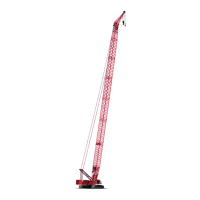Manitowoc Published 05-09-17, Control # 011-29 3-29
16000 OPERATOR MANUAL OPERATING CONTROLS AND PROCEDURES
NOTE: For cranes meeting 2010 European Requirements
and with crane software version FCN 2.654 and
newer, the luffing jib cannot be lowered after JIB
MAXIMUM UP 2 limit is contacted until the limit
switch is reset.
When the limit is contacted, operation
will stop and the jib up prompt (shown
to right) will appear on the main
display.
Once the prompt appears, release the
control handle to off and press the
confirm button (shown to right) to
reset the limit switch. The luffing jib
can then be lowered.
Luffing Jib Down Limit
Two luffing jib down limits are provided:
• JIB MAXIMUM DOWN 1 (minimum working angle):
For PAST PRODUCTION cranes (prior to crane
software version FCN 2.654), this programmed limit
does not stop operation. It only activates Fault 50 alarm
when the boom to jib angle is 70°.
For CURRENT PRODUCTION cranes (with software
version FCN 2.654 and newer) this programmed limit
stops operation when the boom to jib angle is 70°.
• JIB MAXIMUM DOWN 2 (minimum angle):
automatically stops the luffing jib when the boom to jib
angle is 67°.
NOTE: For cranes with software version FCN 2.654 and
newer, the JIB MAXIMUM DOWN 2 limit can be
bypassed if the limit switch malfunctions. If the limit
switch stops the luffing jib before it reaches the
minimum angle given in the Luffing Jib Raising
Procedure Chart, proceed as follows:
• Release the control handle to off.
• Turn the bypass switch to the bypass position.
• Lower the luffing jib slowly until it is at the
specified minimum angle. Monitor the angle in
the working screen of the RCI/RCL display.
The luffing jib can be raised after either limit is contacted.
NOTE: For cranes meeting 2010 European Requirements
and with crane software version FCN 2.654 and
newer, the luffing jib cannot be raised after JIB
MAXIMUM DOWN 2 limit is contacted until the limit
switch is reset.
When the limit is contacted, operation
will stop and the jib down prompt
(shown to right) will appear on the
main display.
Once the prompt appears, release the
control handle to off and press the
confirm button (shown to right) to
reset the limit switch. The luffing jib
can then be raised.
Minimum Bail Limit
Automatically stops the corresponding drum from lowering
when there are three wraps of wire rope remaining on the
drum.
The load can be raised after the limit is contacted.
The appropriate limit bypass switch must be turned to the
bypass position before the load can be lowered below the
limit.
MAX-ER
®
Mast Stop Retracted
Applies to software version M002066 and newer. Fault #27
will be active when Node-6 is not configured correctly for
crane operation even when MAX-ER
®
is not attached.
Shorting plug must be connected to W66P8 whenever mast
stop cylinder is not present. Shorting plug must be
connected to port W6 of Node-6 whenever cable W66 is not
present. See Section 4 for detailed Node-6 configuration.
WARNING
Falling Boom/Jib Hazard!
Do not lower luffing jib below minimum angle given in
Luffing Jib Raising (and lowering) Procedure Chart.
Structural damage could result, possibly causing boom
and luffing jib to collapse.
WARNING
Falling Load Hazard!
When lowering load below minimum bail limit, do so
slowly with extreme caution. Do not lower load to point
where less than three full wraps of wire rope are on drum;
wire rope could be pulled out of drum allowing load to fall.

